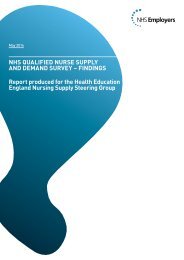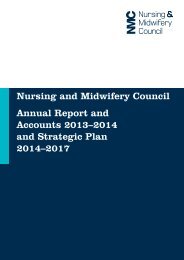Journal_1_2014_final_WEB
Journal_1_2014_final_WEB
Journal_1_2014_final_WEB
Create successful ePaper yourself
Turn your PDF publications into a flip-book with our unique Google optimized e-Paper software.
will be held at this year’s EWMA Conference in Madrid.<br />
The symposium is a collaborative initiative between the Veterinary<br />
Wound Healing Association and EWMA who share the<br />
goal of promoting education and research into the scientific<br />
basis and clinical management of wounds. The objective of the<br />
symposium is to provide a unique platform from which scientists<br />
and other experts in the veterinary and human wound<br />
management disciplines, as well as public health professionals,<br />
can share knowledge, identify interfaces and build the capacity<br />
to draw on the synergies.<br />
EWMA’s EU Advocacy activities related to<br />
antimicrobial resistance<br />
Even within the European Union, scientific policies on the use<br />
of antimicrobial agents vary greatly and result in diverse practices<br />
in the local healthcare systems. Thus, both political incentives<br />
and scientific strategies are needed to stimulate changes<br />
in practice. To facilitate change, the EU is now calling upon<br />
its member states to develop and ensure awareness among<br />
public and health professionals of the threat of antimicrobial<br />
resistance and measures available to counter the problem.<br />
In February, EWMA responded to a public consultation<br />
regarding the use of nanosilver. The public consultation was<br />
launched by the European Commission’s Scientific Committee<br />
on Emerging and Newly Identified Health Risks (SCENIHR).<br />
In the response, it was expressed that EWMA believe in the<br />
use of non-antibiotic antimicrobial agents as the first line<br />
of defence against topical infections and that this approach<br />
could help save valuable antibiotics for urgent and last-resort<br />
treatment of life-threatening conditions. However, to improve<br />
the evidence base, large-scale clinical studies to investigate the<br />
clinical efficacy of non-antibiotic antimicrobial agents (antiseptics),<br />
including silver, are needed and should be encouraged<br />
and incentivised.<br />
EWMA is continuously contributing to the EU’s commitment<br />
to face the challenges of antimicrobial resistance. Read<br />
more about the advocacy activities of EWMA in this issue.<br />
Biofilm courses<br />
Last year, EWMA offered its first practical course on biofilm.<br />
The cause was developed in association with the University of<br />
Copenhagen. It was a great success; for <strong>2014</strong>, two courses are<br />
planned that would include even more individual hands-on<br />
experiments in the laboratories. The biofilm courses introduce<br />
the participants to the topic of biofilms and their huge impact<br />
on chronic infections. Through lectures and a full day of<br />
hands-on experiments, the participants gain an understanding<br />
of biofilms and useable knowledge of how and why to implement<br />
biofilms into their research or product portfolio. m<br />
UPCOMING INITIATIVES<br />
IN <strong>2014</strong> -2015<br />
EWMA leg ulcer recommendations<br />
The objective of this project is to produce a practical<br />
guidance document on leg ulcer treatment, that may<br />
be applicable within the different clinical settings for<br />
leg ulcer treatment in Europe.<br />
EWMA recommendations on Negative<br />
Pressure Wound Therapy (NPWT)<br />
These recommendations will describe the available<br />
NPWT devices (including their application and use),<br />
the health economic aspects of use of NPWT technology<br />
and the eHealth perspectives on the use of<br />
NPWT technology.<br />
Promoting Appropriate Use of Antibiotics<br />
and Non-Antibiotic Antimicrobial Agents<br />
in Wound Care<br />
The goal of this project is to develop a clinical decision<br />
support tool. The tool will facilitate appropriate<br />
use of antibiotics and non-antibiotic antimicrobial<br />
agents in wound management.<br />
Wound survey Germany<br />
The objective of the survey will be to identify the<br />
number and type of wounds under treatment, and<br />
provide an estimate of the resource consumption<br />
directly attributable to wound care at an organisational<br />
level.<br />
This will be carried out in collaboration with the German<br />
Wound Organisation ICW.<br />
Home Care-Wound Care UK<br />
A guideline for wound care within the UK home care<br />
services will be developed, based on the recommendations<br />
provided by the EWMA Home Care - Wound<br />
Care document. This will be done in collaboration<br />
with relevant organisations in the UK.<br />
EWMA recommendations for nurse education<br />
The recommendations will define learning outcomes<br />
related to the different levels of education. The<br />
objective is to eliminate inconsistencies in wound<br />
care education within European nurse education<br />
programmes.<br />
EWMA <strong>Journal</strong> <strong>2014</strong> vol 14 no 1 89




